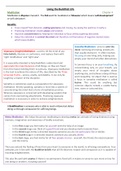Living the Buddhist Life
Meditation Chapter 4
Meditation is dhyana in Sanskrit. The Pali word for meditation is 'bhavana' which means ‘self-development’
or self-cultivation'.
Benefits:
• Frees oneself from delusion, ending ignorance and craving, by seeing the world as it really is.
• Practising meditation creates peace and wisdom.
• Improves concentration by helping the individual to focus without getting distracted.
• Helps the individual to control the mind and therefore rid themselves of negative mental states
which cause dukkha.
Samatha Meditation - aims to calm the
mind, removing all craving, anxiety etc.
Vipassana (insight) Meditation - used to rid the mind of any
that usually distract it. It often involves
false beliefs, illusions or confusions, and replace them with
focusing on one thing only, helping you
‘right mindfulness’ and ‘right view’.
empty your mind of all other distractions.
It is especially intended to help Buddhists understand and
A common focus is on your breathing. By
appreciate the impermanence of all things, so they are freed
concentrating only on your breath, you
from this illusion binding them to samsara. Vipassana meditation
empty your mind of thoughts about
is the tool to achieve the nature of life, described by the Three
anything else, and achieve a deep stillness
Universal Truths – anicca, anatta, and dukkha. It can only be
and tranquillity. An object that is used as
taught by a master of the discipline.
a focus in samatha meditation is called
kasina. This could be anything but
Samatha is sometimes used as a preparation for vipassana
common objects include a candle flame,
meditation. Strictly speaking, samatha is more like a system of
tree, stone or coloured disc.
concentrating the mind than a form of meditative practice.
Whereas vipassana is concerned with developing wisdom that
comes from overcoming attachments. Practising vipassana
meditation is necessary in order to achieve enlightenment.
A Boddhisattva is someone who is able to reach nirbana but delays
doing so through compassion for suffering beings.
Metta Meditation - this helps the person meditating to develop metta (an attitude of loving kindness) using
memory, imagination and awareness of bodily sensations.
- In the first stage you feel metta for yourself with the help of an image
- In the second stage you think of a good friend and you develop metta towards them.
- In the third stage metta is directed towards someone you do not particularly like or dislike.
- In the fourth stage it is directed towards someone you actually dislike.
- In the last stage, you feel metta for all four people at once - yourself, the friend, the neutral person
and the enemy.
Then you extend the feeling of love from your heart to everyone in the world, to all beings everywhere. Your
attitudes are in line with the Buddhist beliefs that all life deserves respect and compassion as it is capable of
reaching enlightenment.
This also fits well with anatta; if there is no permanent, fixed self, it makes no sense to care more or less for
one being or another, including yourself.
, Chanting
Chanting exists in all types of Buddhism and is used either to prepare for mediation by focusing the mind
or as a form of devotional practice towards the Buddha and also Bodhisattvas.
Chanting helps develop a positive mindset – Dhammapada 1-2
‘Phenomena are preceded by the heart, ruled by the heart, made of the heart.
If you speak or act with a corrupted heart,
then suffering follows you, as the wheel of the cart follows the track of the ox that pulls it.
Phenomena are preceded by the heart, ruled by the heart, made of the heart.
If you speak or act with a calm, bright heart,
then happiness follows you, like a shadow that never leaves.’
Chanting is one way to follow the instruction of the Buddha to seek
refuge in the Buddha, dhamma and sangha - Dhammapada 190-191.
‘He who has gone for refuge to the Buddha, the dhamma and the
sangha, penetrates with transcendental wisdom the Four Noble
Truths — suffering, the cause of suffering, the cessation of suffering,
and the Noble Eightfold Path leading to the cessation of suffering.’
Chanting the Three Refuges/Jewels unites
Buddhists by reminding them that they all can Chanting helps a Pure Land Buddhist reach the Pure Land
seek support from the same aspects of Buddhism
Followers of Mahayana aim to reach the ‘pure land’ – a
The refuges are also important in chanting by kind of heaven beyond the three marks of existence. They
Triratna Buddhists. Trirtatna are a modern
will chant the name of the Bodhisattva Amitabha in their
Buddhist group, that draw ideas from and welcome meditiation. This is because the Amitāyus Meditation
members from all different branches of Buddhism. Sutra tells them that anyone can reach the pure land by
They see the refuges as something that unites all contemplating him or even just calling his name,
Buddhists, and so brings them all together. regardless of their kamma.
Many Buddhists chant the Triratna. Often, this is
referred to as ‘going for refuge. This simple chant
reminds Buddhists that Trirtatna offer them Koan - a paradoxical anecdote or riddle without
wisdom, guidance, friendship and knowledge. a solution, used in Zen Buddhism to demonstrate
the inadequacy of logical reasoning and provoke
‘I go to the Buddha for refuge, I go to the Dhamma enlightenment, focusing the mind. e.g. Does a
for refuge, I go to the Sangha for refuge.’ room cease to exist when I close the door?
Chanting helps focus on unlocking the Maitreya (Buddha nature within) - these are mantras.
- Nam Myoho Renge Kho is a chant from the Mahayana tradition and more specifically from Nicheren
Buddhism, Japan.
- Myoho Renge Kho is the Japanese name for the Lotus sutra, and the ‘Nam’ means putting it into action.
Remember the Lotus sutra emphasises the Buddha nature we all have within us, also Mahayana




